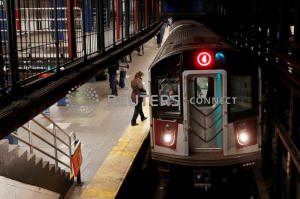Overnight closure of New York subways may presage bigger changes
 Send a link to a friend
Send a link to a friend
 [May 01, 2020]
By Nathan Layne [May 01, 2020]
By Nathan Layne
NEW YORK (Reuters) - New York City's
subway, the ear-splitting, nerve-jangling system that New Yorkers and
tourists alike love to hate, is taking the unprecedented step of halting
overnight service in order to clean train cars, a likely prelude to
bigger changes as the largest U.S. mass transit system works to rebound
from a pandemic that has slashed ridership.
The subway system, whose more than 600 miles of track criss-cross four
of New York's five boroughs, will close between 1 a.m. and 5 a.m.
beginning May 6 to allow crews to disinfect the cars each night to
prevent further spread of the novel coronavirus, New York Governor
Andrew Cuomo said on Thursday. The city's buses will also be cleaned
every night, he said.
Commuter advocates and transit experts saw the move, the first for a
subway system known for its round-the-clock service, as signaling a
period of sweeping change for the Metropolitan Transportation Authority,
the state-controlled agency that oversees a system that until recently
carried 9 million passengers a day.
The MTA is talking with transport agencies around the world to glean
best practices while looking at how to enforce social distancing and at
staggered hours for businesses returning to work, an issue being
discussed with governors and corporate and labor leaders, a spokesman
for the agency said.

MTA's plan to "bring riders back" to the transit system will focus on
safety, the agency's spokeswoman, Abbey Collins, said. "We will also be
asking our customers to change their behavior, including wearing face
coverings."
The changes come as the MTA grapples with a more than 90% decline in
subway ridership as New York locked down to fight the coronavirus. The
agency has also stopped collecting bus fares in order to protect its
drivers, further denting revenues.
Earlier this month MTA Chairman Pat Foye asked for another $3.9 billion
in federal aid, on top of the $3.8 billion already allocated to the
agency, to cover pandemic-related costs expected to climb as high as
$8.5 billion.
Foye has said federal funding also is needed to preserve a $51.5 billion
capital budget for 2020-2024 aimed at modernizing the subway's
antiquated signal systems and expansion projects.
Philip Plotch, the author of "Last Subway: The Long Wait for the Next
Train in New York City," said the MTA would have to look at cutting
capacity for each subway car to achieve some measure of social
distancing. Under normal conditions, each car can carry about 100
riders, though he expects ridership to remain depressed for some time.
"A lot of businesses are not going to want to open," he said. "Clearly
you are not going to have the same level of tourists, and schools are
going to be slow for a while."
[to top of second column]
|

A conductor wears a mask while waiting for passengers to load into
the New York City Subway as the outbreak of the coronavirus disease
(COVID-19) continues in the Manhattan borough of New York, U.S.,
April 30, 2020. REUTERS/Lucas Jackson

"A SHADOW OF ITS FORMER SELF"
New York has been at the center of the pandemic in the United
States, accounting for nearly half of the 60,000 Americans killed by
COVID-19, the disease caused by the virus.
When the virus hit, the city was in the process of rewriting the bus
routes in all five boroughs, part of a reform of a transit system
that has been criticized for not serving the communities most in
need.
Ben Fried, a spokesman at TransitCenter, a foundation which
advocates for improving public transit systems, pointed to San
Francisco's move to concentrate bus service on the highest ridership
lines and serve hospitals and low-income areas as a potential model
for New York.
"I think that is the way to position transit for the future and for
safe operations in a post-COVID world," Fried said. "If the bus
system can absorb that it means there is going to be less crowding
on the subway. Even if it's 5 to 10 percent it would be
significant."
Danny Pearlstein, policy and communications director at Riders
Alliance, a commuter advocacy group, said the closing of
early-morning subway service should be temporary. It is more
important that the MTA look at ways to increase the frequency of
subway service, especially during rush hour, he said, though that
would rely on federal funding that may or may not materialize.
Pearlstein also advocated a rethink to cater train and bus service
more toward essential workers such as nurses and grocery and
pharmacy clerks, who may take earlier- or later-than-normal trains.
"The subway has been seen as great equalizer. What we need now is
equitable service," Pearlstein said. "If New York is not going be a
shadow of its former self, transit has to work for people in
different ways than it has in the past."

(Reporting by Nathan Layne in Wilton, Connecticut; Editing by Leslie
Adler)
[© 2020 Thomson Reuters. All rights
reserved.] Copyright 2020 Reuters. All rights reserved. This material may not be published,
broadcast, rewritten or redistributed.
Thompson Reuters is solely responsible for this content. |